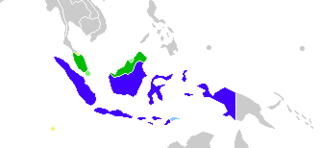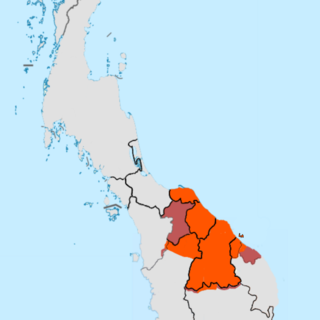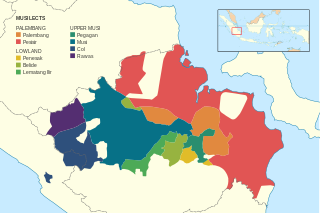Related Research Articles

Malay is an Austronesian language that is an official language of Brunei, Indonesia, Malaysia, and Singapore. It is also spoken in East Timor and parts of Thailand. Altogether, it is spoken by 290 million people across Maritime Southeast Asia.
A phonemic orthography is an orthography in which the graphemes correspond consistently to the language's phonemes, or more generally to the language's diaphonemes. Natural languages rarely have perfectly phonemic orthographies; a high degree of grapheme–phoneme correspondence can be expected in orthographies based on alphabetic writing systems, but they differ in how complete this correspondence is. English orthography, for example, is alphabetic but highly nonphonemic.

Jawi is a writing system used for writing several languages of Southeast Asia, such as Acehnese, Magindanawn, Malay, Mëranaw, Minangkabau, Tausūg, and Ternate. Jawi is based on the Arabic script, consisting of all 31 original Arabic letters, six letters constructed to fit phonemes native to Malay, and one additional phoneme used in foreign loanwords, but not found in Classical Arabic, which are ca, nga, pa, ga, va, and nya.

Malaysian Malay or Malaysian —endonymically within Malaysia as Standard Malay or simply Malay — is a standardized form of the Malay language used in Malaysia and also used in Brunei and Singapore. Malaysian Malay is standardized from the Johore-Riau dialect of Malay, particularly a branch spoken in the state of Johore south of the Malay Peninsula. It is spoken by much of the Malaysian population, although most learn a vernacular Malay dialect or another native language first.
Indonesian and Malaysian Malay are two standardised varieties of the Malay language, the former used officially in Indonesia and the latter in Brunei, Malaysia and Singapore. Both varieties are generally mutually intelligible, yet there are noticeable differences in spelling, grammar, pronunciation and vocabulary, as well as the predominant source of loanwords. The differences can range from those mutually unintelligible with one another, to those having a closer familial resemblance. The regionalised and localised varieties of Malay can become a catalyst for intercultural conflict, especially in higher education.

Ă or ă, usually referred to in English as A-breve, is a letter used in standard Romanian and Vietnamese orthographies. In Romanian, it is used to represent the mid-central unrounded vowel, while in Vietnamese it represents the short a sound. It is the second letter of the Romanian, Vietnamese, and the pre-1972 Malaysian alphabets, after A.

Kelantan-Pattani Malay is an Austronesian language of the Malayic subfamily spoken in the Malaysian state of Kelantan, as well as in Besut and Setiu districts of Terengganu state and the Perhentian Islands, and in the southernmost provinces of Thailand. It is the primary spoken language of Thai Malays and used as a lingua franca by ethnic Southern Thais in rural areas, Muslim and non-Muslim and the Sam-Sam, a mostly Thai-speaking population of mixed Malay and Thai ancestry.

Malay was first used in the first millennia known as Old Malay, a part of the Austronesian language family. Over a period of two millennia, Malay has undergone various stages of development that derived from different layers of foreign influences through international trade, religious expansion, colonisation and developments of new socio-political trends. The oldest form of Malay is descended from the Proto-Malayo-Polynesian language spoken by the earliest Austronesian settlers in Southeast Asia. This form would later evolve into Old Malay when Indian cultures and religions began penetrating the region, most probably using the Kawi and Rencong scripts, some linguistic researchers say. Old Malay contained some terms that exist today, but are unintelligible to modern speakers, while the modern language is already largely recognisable in written Classical Malay of 1303 CE.
The modern Malay and Indonesian alphabet consists of the 26 letters of the ISO basic Latin alphabet. It is the more common of the two alphabets used today to write the Malay language, the other being Jawi. The Latin Malay alphabet is the official Malay script in Indonesia, Malaysia and Singapore, while it is co-official with Jawi in Brunei.
Tan Sri Zainal Abidin bin Ahmad or better known by the moniker Za'aba, was a Malaysian writer and linguist. He modernised the Malay language with the publication of a series of grammar books entitled Pelita Bahasa in 1936 at the Sultan Idris Training College. The book contained guidelines in modernising the structure of classical Malay, transforming it into the language that is in use today: the most significant change was the switch from the conventional passive to the modern active form of syntax.

Kedah Malay or Kedahan or as it is known in Thailand, Syburi Malay is a Malayic language mainly spoken in the northwestern Malaysian states of Perlis, Kedah, Penang, and northern Perak and in the southern Thai provinces of Trang and Satun. The usage of Kedah Malay was historically prevalent in southwestern Thailand before being superseded by the Thai language. Enclaves of Kedah Malay can be found in Kawthaung District in Myanmar; Ranong and Krabi in upper southern Thailand; Jaring Halus, Langkat and Aceh in Sumatra, Indonesia and up north in Bangkok, central Thailand, where most of the Kedah Malay speakers are descendants of historical settlers from Kedah.

Acehnese or Achinese is an Austronesian language natively spoken by the Acehnese people in Aceh, Sumatra, Indonesia. This language is also spoken by Acehnese descendants in some parts of Malaysia like Yan, in Kedah. Acehnese is used as the co-official language in the province of Aceh, alongside Indonesian.

Palembang, also known as Palembang Malay, is a Malayic variety of the Musi dialect chain primarily spoken in the city of Palembang and nearby lowlands, and also as a lingua franca throughout South Sumatra. Since parts of the region used to be under direct Javanese rule for quite a long time, Palembang is significantly influenced by Javanese, down to its core vocabularies.
This article explains the phonology of Malay and Indonesian based on the pronunciation of Standard Malay, which is the official language of Brunei and Singapore, "Malaysian" of Malaysia, and Indonesian the official language of Indonesia and a working language in Timor Leste. There are two main standards for Malay pronunciation, the Johor-Riau standard, used in Brunei and Malaysia, and the Baku, used in Indonesia and Singapore.
The Republican Spelling System or Soewandi Spelling was the orthography used for Indonesian from 17 March 1947 until 1972.

The Van Ophuijsen Spelling System was the Romanized standard orthography for the Indonesian language from 1901 to 1947. Before the Van Ophuijsen Spelling System was in force, the Malay language in the Dutch East Indies did not have a standardized spelling, or was written in the Jawi script. In 1947, the Van Ophuijsen Spelling System was replaced by the Republican Spelling System.
The Indonesian-Malaysian orthography reform of 1972 was a joint effort between Indonesia and Malaysia to harmonize the spelling system used in their national languages, which are both forms of the Malay language. For the most part, the changes made in the reform are still used today. This system uses the Latin alphabet and in Malaysia is called Joint Rumi Spelling, and in Indonesia Perfect Spelling or Enhanced Spelling. It replaced the Za'aba Spelling that was previously standard in Malaysia, Singapore and Brunei, and the Republican Spelling System in Indonesia.
Pahang Malay is a Malayic language spoken in the Malaysian state of Pahang. It is regarded as the dominant Malay dialect spoken along the vast riverine systems of Pahang, but co-exists with other Malay dialects traditionally spoken in the state. Along the coastline of Pahang, Terengganu Malay is spoken in a narrow strip of sometimes discontiguous fishing villages and towns. Another dialect spoken in Tioman island is a distinct Malay variant and most closely related to Riau Archipelago Malay subdialect spoken in Natuna and Anambas islands in the South China Sea, together forming a dialect continuum between the Bornean Malay and the Mainland Peninsular/Sumatran Malay.
Perak Malay is one of the Malay dialects spoken within the state of Perak, Malaysia. Although it is neither the official language nor the standard dialect in the whole state of Perak, its existence which co-exists with other major dialects in the state of Perak still plays an important role in maintaining the identity of Perak. In spite of the fact that there are five main dialects traditionally spoken in Perak, only one of which is intended by the name "Perak Malay". There are subtle phonetic, syntactic and lexical distinctions from other major Malay dialects. Perak Malay can be divided into two sub-dialects, Kuala Kangsar and Perak Tengah, named after the daerah (districts) where they are predominantly spoken.
The Congress Spelling System is a spelling reform of Malay Rumi Script introduced during the third Malay Congress held in Johor Bahru and Singapore in 1956. The main characteristics of the system are the use of symbols in the Americanist phonetic notation, going by the dictum of one symbol for one phoneme, and the new proposition in the writing of diphthongs.
References
- ↑ Leow 2018 , p. 89
- ↑ Asmah Omar 1989
- ↑ Leow 2018 , p. 89
- ↑ Leow 2018 , p. 208
- ↑ Muhammed Salehudin Aman 2019
- ↑ Asmah Omar 1989
- ↑ Leow 2018 , p. 89
- ↑ Asmah Omar 1989
- ↑ Muhammed Salehudin Aman 2019
- ↑ Asmah Omar 1989
- ↑ Leow 2018 , p. 89
- ↑ Subhan, Mohamed Aidil (27 March 2020). Issues in Malay Language Planning: Heart Truths. ISBN 9781543757439.
- ↑ Asmah Omar 1989
- ↑ Asmah Omar 1989
- ↑ Asmah Omar 1989
- ↑ Leow 2018 , p. 89
- ↑ Leow 2018 , p. 89
- ↑ Asmah Omar 1989
- ↑ Leow 2018 , p. 89
- ↑ Mohd Zaidi Abd Rozan & Mikami 2007 , p. 139
- ↑ Asmah Omar 1989
- ↑ Mohd Zaidi Abd Rozan & Mikami 2007 , p. 139
- ↑ Asmah Omar 1989
- ↑ Leow 2018 , p. 89
- ↑ Mohd Zaidi Abd Rozan & Mikami 2007 , p. 139
- ↑ Mohd Zaidi Abd Rozan & Mikami 2007 , p. 139